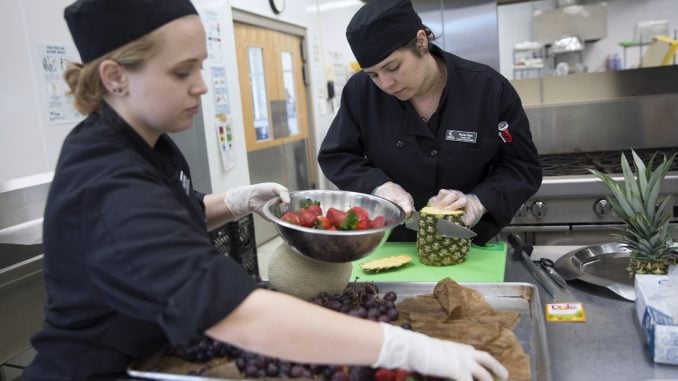
WILSON — Today across North Carolina, all 58 community colleges are celebrating Community College Day. College students, faculty, staff and administrators are traveling to the General Assembly to showcase, discuss and demonstrate the role community colleges play in North Carolina and equally sharing the role they play in their communities.
“If community colleges were absent, you would see a fundamentally different North Carolina,” said Dr. Tim Wright, president of Wilson Community Colleges. “There would be a poorer quality of life and a lack of hope for individuals and families.”
Community colleges are the best at adaptation. We adapt ourselves to continuously serve the growing and realistic needs of our communities with support of state and local resources,” he added.
North Carolina Community Colleges served more than 700,000 North Carolinians last year compared to 220,000 served by the state’s university system. Of the state’s wage earners, 40 percent have received education or training from a community college. Collectively, community colleges add $21.5 billion to the state’s economy annually and employ more than 375,000 people.
“We’re moving people from $8-an-hour jobs to $18-an-hour jobs,” said Dr. Stephen Scott, president of Wake Tech. “We’re forever changing their lives. Community colleges are getting involved by providing residents with education and training that increases their income. In a year’s time they have increased to $20,000 annually.”
When the economy is tough, people will return to the community colleges to get reskilled,” he added. “All of our community colleges offer unique trainings important to the area they serve. We’re community colleges we are committed to the community.”
In order to operate a continuously growing student population, meet the needs of incoming business and industries requiring worker training, expand early college high school programs to meet community requests, pay the salaries of dedicated faculty and staff, expand infrastructure to house growing curriculums, and more, state funding is required.
The NC Community College budget request stands at $74 million and Gov. Roy Cooper has released his “NC Grow: Free Community College Scholarship Proposal” to offer free community college tuition for any good student and graduate of a North Carolina high school.
“Our students at community colleges are very fragile in terms of economics, life expectations and family,” said Dr. David Johnson, president of Johnston Community College. “Any way we can bring additional resources to the table in order to make their pathway into the community college seamless and successful, I am for that.”
Every North Carolinian lives within a 30-minute drive of a community college campus and the state has the lowest community college tuition rates in the Southeast.
For people like Christopher Blue, a high school student enrolled in the Vance-Granville Early College High School, it provides an opportunity to earn a high school diploma and an associate’s degree.
“My mother graduated as a registered nurse from Vance-Granville and I am a second generation community college student,” said Blue. “By being in the Early College, I am developing leadership skills and being exposed to more opportunities provided to me by Vance-Granville.”
He added, “I’m working with the county Boys and Girls Clubs and encouraging other youth to take advantage of these opportunities in their communities.”
The community colleges have created strong employees within professions across the state to those specific to communities. Of the nurses employed in North Carolina, 50 percent are graduates of community colleges. For the Bridgestone Tires plant in Wilson, they have sent more than 6,000 of their employees to be trained at Wilson Community College.
The North State Journal rounded up several of the community colleges located in the North Central Prosperity Zone to highlight some of the unique programs they offer their students.
Vance-Granville CC, HendersonWelding and Mechatronics Engineering TechnologyWelding has been a part of Vance-Granville for 25 years with Mechatronics joining the curriculum in 2014. The programs are designed to provide students with an understanding of science, mathematics, technology and applications in the industry.
“There is a huge future for people who choose technology as their calling. By studying and receiving degrees in these fields, this becomes their gateway for jobs in the industry,” said Keith Shearon, department chair.
Wake Technical CC, Raleigh
3D Printing, Additive manufacturing, or 3-D Printing, is transforming how things are made from the scale of the individual tinkerer to the largest industries. Included in the engineering track, 3-D printing and full body scanners are designed to help students understand machine setup, maintenance and the growing technology of the printing industry.
“We are a technical college and offering these programs are right up our alley. Employers in the technology industry are looking for employees to have this type of skill,” said David West, 3D media specialist.
Piedmont CC, Roxboro
Film and Video Production Technology
This unique program caters to camera assistants, lighting technicians, sound recordists, makeup artists, set dressers and production assistants. Developing skills in the film industry, these students are ready to compete for entry-level jobs upon completion of the program.
“YouTube videos have become the biggest money maker. We are training students on developing their videos, but also how to be on set, use grips, assist with productions, work with screenplays and providing them more credentials and information to be successful,” said Jesse Knight, coordinator and instructor of Film and Video Production.
Edgecombe Community College, Tarboro and Rocky Mount
Health Sciences
With the assistance of a patient simulator and mobile lab, students are being trained in situations as real and life-like as possible. Simulated mannequins can breathe, blink and provide students with opportunities to treat bleed outs, seizures, births and amputations.
“By putting students in situations identical to real-life experiences and providing them with the equipment they will use on the job, we are better preparing them for a future in the healthcare field,” said Robert P. Whistler, coordinator of Emergency Services and Public Safety Training.
Nash CC, Rocky Mount
Electric Line Construction Academy
Electrical infrastructure needs regular maintenance and upgrading to maintain the safety of residents and a standard of living. The Electric Line Construction Academy provides students will more than 400 hours of combined classroom and field training.
“Half of the country’s electrical linemen are fixing to retire. There is a high demand for this trade,” said Brandon Shook, electric line construction technology instructor.



